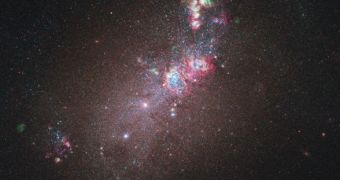Recent observations conducted on a dwarf galaxy is allowing astronomers a closer view into the processes and chains of events that eventually lead to the formation of a new star.
The galaxy they recently looked at is called NGC 4214, and it was found to produce new stars at a high pace. Massive hydrogen gas clouds are spread throughout, ready to become molecular clouds from which new stars will condense.
Scientists now hope that using the Hubble Space Telescope to study the object will enable them to see what's going on with extreme clarity. The instrument suite on the observatory has been changed in May 2009, and now Hubble is better at conducting observations than ever before.
What experts deemed interesting about this particular dwarf galaxy is that it contained a vast diversity of space objects, ranging from new, blue stars to old, red supergiants and very old star clusters.
Young, extremely hot star clusters are also visible in the new images, which were collected using the Wide Field Camera 3 (WFC3) instrument. Temperatures within these clusters can reach between 18,000 and 90,000 degrees Fahrenheit (10,000 to 50,000 degrees Celsisus), Space reports.
Hubble also revealed the existence of interesting patterns in the glowing hydrogen gas reserves NGC 4214 has. One of them, most likely carved out by stellar winds interacting with the gas, has the shape of a heart, and this is probably the feature that distinguishes this galaxy from all the rest.
However, for all its beauty, this area can no longer form new stars, due to the fact that its gas reserves were scattered in all directions by the intense stellar winds blowing in the region. Without the clouds, it's impossible for the hydrogen to accumulate in the amounts needed to form new stars .
At this point, experts have a fairly good understanding of how stellar objects come to be. Their roots can be traced to massive, molecular hydrogen clouds, that grow bigger and bigger by accreting even more gas from their surroundings.
As these clouds increase in size and mass, they reach a threshold beyond which their gravitational pull becomes too strong. The formations then collapse in on themselves. As the gas races towards the center of the cloud, friction causes it to warm up, and eventually ignite.
As this happens, a protostar is formed. It may or may not turn into a real star, but astronomers agree that this is the most likely formation mechanism. Its intricacies, however, are a lot less understood.
By studying NGC 4214, a dwarf galaxy located about 10 million light-years away in the constellation of Canes Venatici, experts hope to get a better understanding of the still-mysterious aspects of stellar formation, Space reports.

 14 DAY TRIAL //
14 DAY TRIAL //